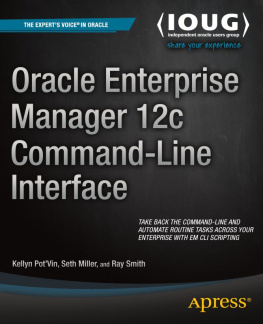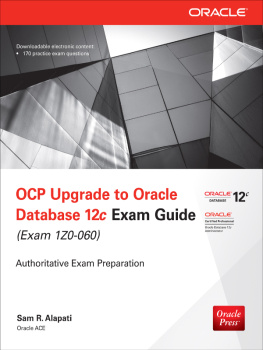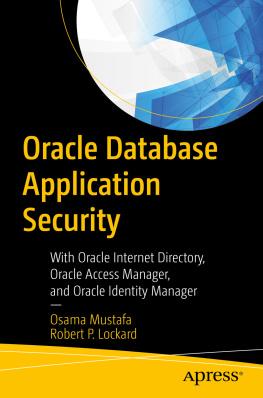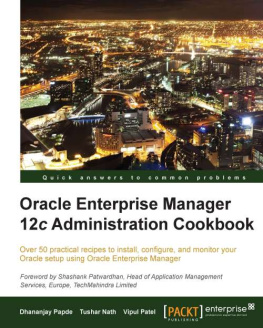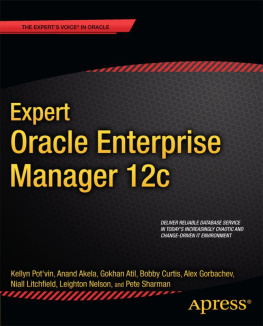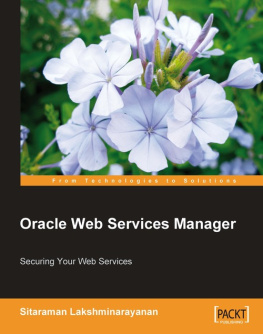Smith - Oracle enterprise manager 12c command-line interface
Here you can read online Smith - Oracle enterprise manager 12c command-line interface full text of the book (entire story) in english for free. Download pdf and epub, get meaning, cover and reviews about this ebook. year: 2014, publisher: Apress, genre: Home and family. Description of the work, (preface) as well as reviews are available. Best literature library LitArk.com created for fans of good reading and offers a wide selection of genres:
Romance novel
Science fiction
Adventure
Detective
Science
History
Home and family
Prose
Art
Politics
Computer
Non-fiction
Religion
Business
Children
Humor
Choose a favorite category and find really read worthwhile books. Enjoy immersion in the world of imagination, feel the emotions of the characters or learn something new for yourself, make an fascinating discovery.
- Book:Oracle enterprise manager 12c command-line interface
- Author:
- Publisher:Apress
- Genre:
- Year:2014
- Rating:3 / 5
- Favourites:Add to favourites
- Your mark:
- 60
- 1
- 2
- 3
- 4
- 5
Oracle enterprise manager 12c command-line interface: summary, description and annotation
We offer to read an annotation, description, summary or preface (depends on what the author of the book "Oracle enterprise manager 12c command-line interface" wrote himself). If you haven't found the necessary information about the book — write in the comments, we will try to find it.
Smith: author's other books
Who wrote Oracle enterprise manager 12c command-line interface? Find out the surname, the name of the author of the book and a list of all author's works by series.
Oracle enterprise manager 12c command-line interface — read online for free the complete book (whole text) full work
Below is the text of the book, divided by pages. System saving the place of the last page read, allows you to conveniently read the book "Oracle enterprise manager 12c command-line interface" online for free, without having to search again every time where you left off. Put a bookmark, and you can go to the page where you finished reading at any time.
Font size:
Interval:
Bookmark:
CHAPTER 1

Architecture
Oracle Enterprise Manager 12c provides a scalable and reliable central repository, a console, and services for managing your all of your Oracle products. Users typically interact with OEM through the OEM console, which has a rich intuitive graphical interface.
The Enterprise Manager Command-Line Interface (EM CLI) provides access to OEM system functionality outside of the console. Interactive EM CLI tasks can replace lengthy click-streams in defining EM administrator accounts and roles, as one example of its usefulness. EM CLI interactive commands can be used in shell scripts or can be CLI invoked through CLIs own scripting mode in Jython.
This book explores different ways you can apply these techniques to simplify and automate tasks in your Oracle environment.
Enterprise Manager Framework
The Oracle Enterprise Manager application runs as a JEE application in a WebLogic Server J2EE domain on a WebLogic server. This combination is known as the Oracle Management Server, or OMS.
Java processes running on the OMS gather and process XML file uploads that come from EM agents on your remote hosts. That information is posted to a repository database, where it is stored in the SYSMAN schema.
When you view a page on your OEM console, the data is assembled from the repository database for presentation. In the same way, commands that you issue from the console are processed through the OMS to update repository information (metric collection or notifications, for instance) or manipulate managed targets either through a call to the EM agent or through an authenticated connection to a remote database or host.
Each command issued by the console executes a Java program. The console solicits and assembles data as well as the input commands required for those routines to execute. Much of the manipulative and query code base can be accessed through EM CLI.
The EM CLI program is itself a lightweight Java program that performs the same activities as the console pages but runs an immediate execution of OMS modules using values passed as command-line inputs; it is often employed in shell scripts or Jython programs.
EM CLI Verbs
Interface commands are referred to as verbs. Each verb performs a single task and either succeeds with reasonable feedback or comes back with a quick and obvious failure message.
Many verbs require input values on the command line. As with a PL/SQL package, your input must be passed to the OMS using very specific syntax. The values are always preceded by a filter keyword, and most input requires your strings to be wrapped in double-quotes.
 Note The authors experiences using quotation marks have been mixed. They are recommended, but often arent required. Well use them for clarity in our examples. You may find that you dont always need them, or that you prefer not to use them.
Note The authors experiences using quotation marks have been mixed. They are recommended, but often arent required. Well use them for clarity in our examples. You may find that you dont always need them, or that you prefer not to use them.
Use the get_targets verb to display or capture a list of the targets in your environment, as follows:
emcli get_targetsTo find only Oracle database targets youd filter your request with the targets keyword:
emcli get_targets -targets="oracle_database"Numerous examples throughout this book demonstrate how verbs and input values are applied. A catalog of EM CLI verbs and their syntax is available in Oracle Support document E17786-x. Be aware that some verbs are tied to management packs that require licensing fees. You can also find online help at the command-line that lists all of the verbs available and their intended use. For example:
emcli helpSummary of commands:
argfile -- Execute emcli verbs from a file
help -- Get help for emcli verbs (Usage: emcli help [verb_name])
login -- Login to the EM Management Server (OMS)
logout -- Logout from the EM Management Server
setup -- Setup emcli to work with an EM Management Server
status -- List emcli configuration details
sync -- Synchronize with the EM Management Server
version -- List emcli verb versions or the emcli client version
Add Host Verbs
continue_add_host -- Continue a failed Add Host session
get_add_host_status -- Displays the latest status of an Add Host session.
list_add_host_platforms -- Lists the platforms on which the Add Host operation can be performed.
list_add_host_sessions -- Lists all the Add Host sessions.
retry_add_host -- Retry a failed Add Host session
submit_add_host -- Submits an Add Host session.
...
The help verb can be filtered with specific verbs to display detailed usage instructions:
emcli help get_targetsemcli get_targets
[-targets="[name1:]type1;[name2:]type2;..."]
[-alerts]
[-noheader]
[-script | -format=
[name:];
[column_separator:"column_sep_string"];
[row_separator:"row_sep_string"];
]
[-config_search="Configuration Search UI Name"]
[-unmanaged]
Description:
Obtain status and alert information for targets.
Options:
-targets=name:type
Name or type can be either a full value or a pattern match
using "%". Also, name is optional, so the type may be
specified alone.
-config_search="Configuration Search UI Name"
Search UI Name should be the display name of the configuration search.
-alerts
Shows the count of critical and warning alerts for each target.
-noheader
Display tabular output without column headers.
-script
This option is equivalent to -format="name:script".
-format
Format specification (default is -format="name:pretty").
-format="name:pretty" prints the output table
in a readable format but is not intended to be parsed by scripts.
-format="name:script" sets the default column separator
to a tab and the default row separator to a newline.
The column and row separator strings may be specified
to change these defaults.
-format="name:csv" sets the column separator to a comma
and the row separator to a newline.
-unmanaged
Get unmanaged targets (no status or alert information)
Output columns:
Status ID Status Target Type Target Name Critical Warning
Examples:
emcli get_targets
Shows all targets. Critical and Warning columns are not shown.
emcli get_targets
-alerts
Shows all targets. Critical and Warning columns are shown.
emcli get_targets
-targets="oracle_database"
Shows all "oracle_database" targets.
emcli get_targets
-targets="%oracle%"
Shows all targets whose type contains the string "oracle".
emcli get_targets
-targets="database%:%oracle%"
Shows all targets whose name starts with "database" and type
contains "oracle".
emcli get_targets
-targets="database3:oracle_database"
-alerts
Shows status and alert information on the Oracle database named
"database3".
emcli get_targets
-config_search="Search File Systems on Hosts"
-targets="oracle%:host"
-alerts
Shows status and alert information of the resulting targets from
configuration search named "Search File Systems on Hosts" and targets
whose name starts with "oracle" and of type "host".
emcli get_targets
-targets="host"
-unmanaged
Shows name and type information for unmanaged host targets.
EM CLI Client Software
The basic OEM installation on a management server preconfigures an EM CLI client as part of OMS Oracle Home. In
Part of EM CLIs strength comes from its flexibility. In addition to the client installation on the OMS server, you can install the EM CLI client on a non-OMS host or even on your desktop.
Installing the EM CLI client consists of downloading and extracting an installation jar file in order to install the binaries, and then configuring the client with connection information for your OMS server. The jar file and installation for its use are available through the OEM console under
Next pageFont size:
Interval:
Bookmark:
Similar books «Oracle enterprise manager 12c command-line interface»
Look at similar books to Oracle enterprise manager 12c command-line interface. We have selected literature similar in name and meaning in the hope of providing readers with more options to find new, interesting, not yet read works.
Discussion, reviews of the book Oracle enterprise manager 12c command-line interface and just readers' own opinions. Leave your comments, write what you think about the work, its meaning or the main characters. Specify what exactly you liked and what you didn't like, and why you think so.

